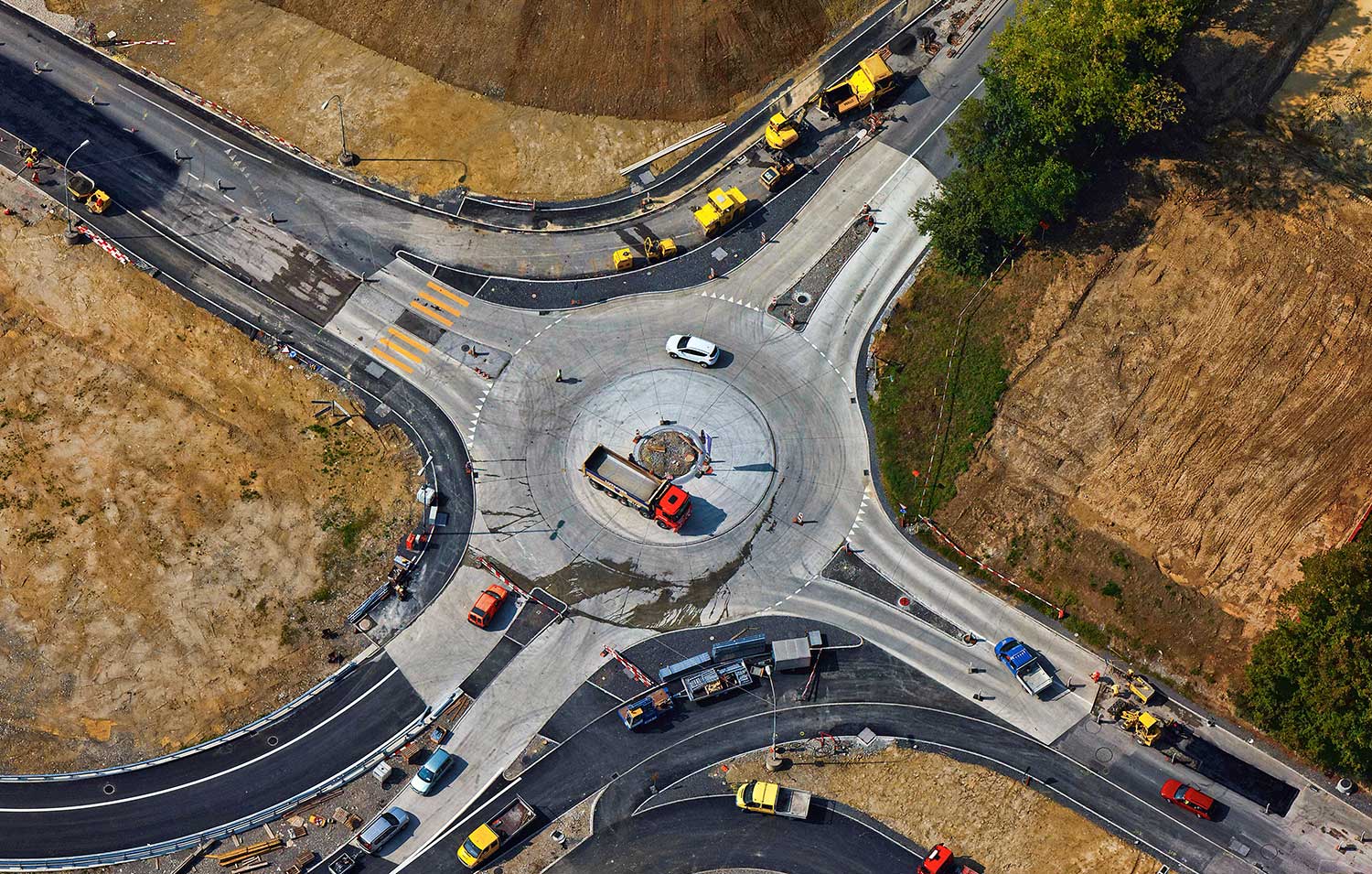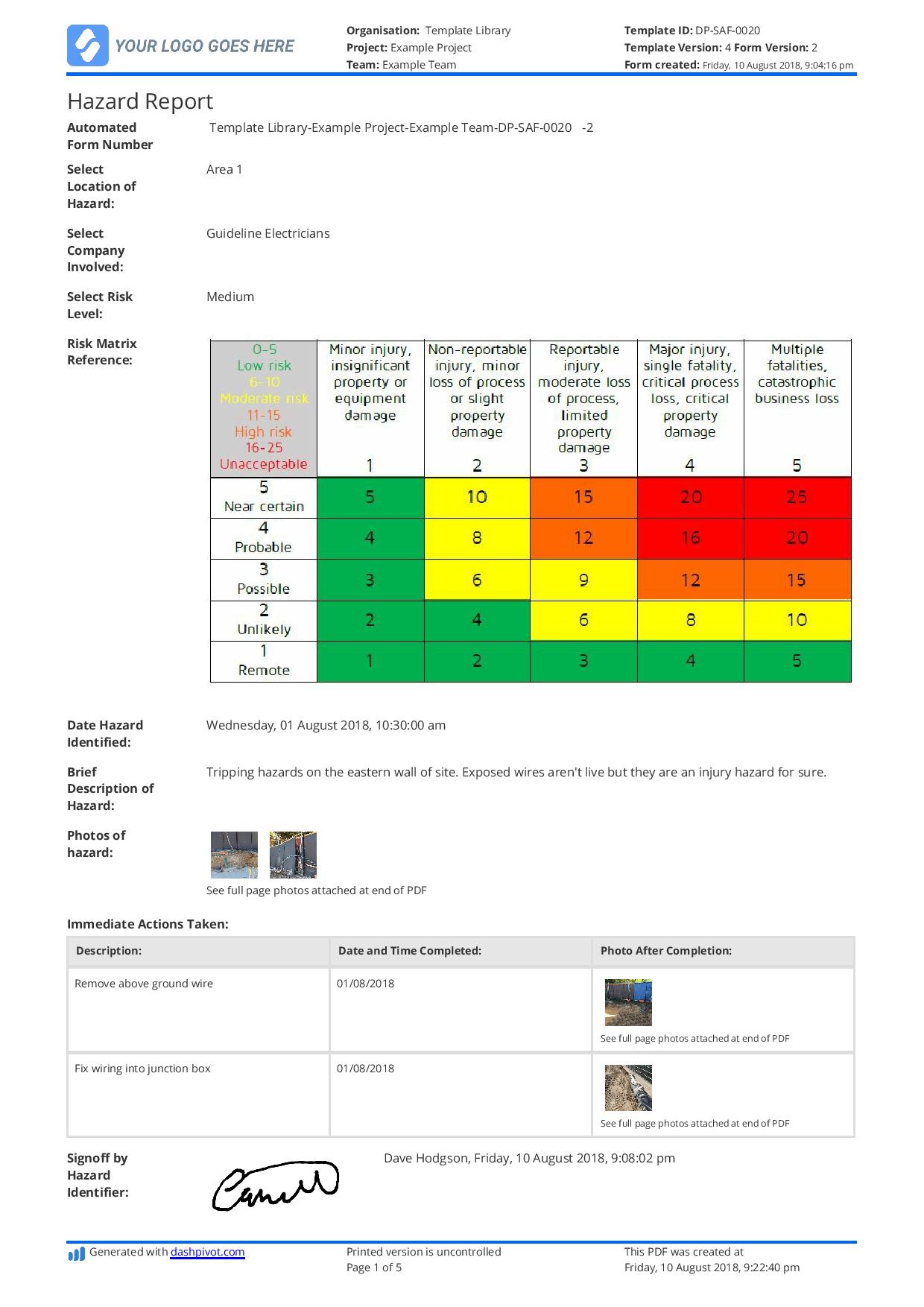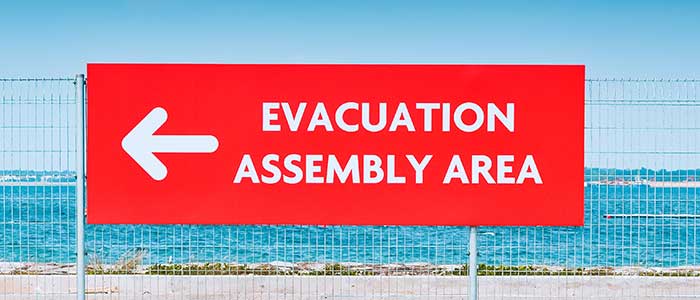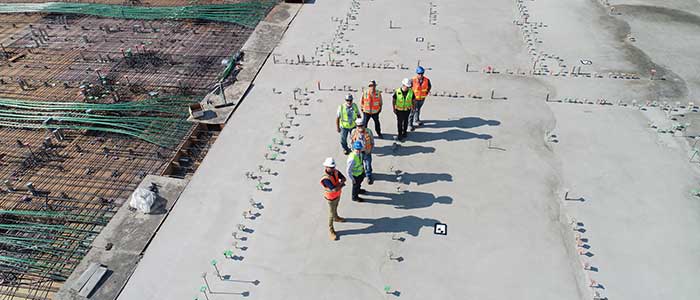Safety – Hazard report example
Example hazard report: What your hazard report form should look like
In this article, we'll show you an example of a hazard report with all of the key hazard report components, and provide more detail and useful resources you can use to improve your hazard reporting and safety compliance.

What is a hazard report?
The construction and other site based industries including oil and gas, mining, wind farms and forestry operate in extremely hazardous conditions. These industries are many of the most dangerous in the world - which is reflected in the number of incidents, injuries and fatalities every year.
Although these incidents have declined in recent years, thanks to an increase in the increased focus on the safety and wellbeing of workers and improved safety processes and systems.
While some of these processes and systems are still reactionary - intending to understand why an incident occurred and reduce the likelihood of it happening again - some of the other processes and forms used amongst these industries are proactive.
The goal of proactive safety measures like hazard reporting is to uncover or find hazards before they turn into accidents and incidents. To document and share hazards with the rest of the team so that something is done about the hazard before it becomes a more serious issue.
A hazard report is the most common way to report hazards. A hazard report form is the document used to ensure that appropriate actions are taken to prevent the hazard from turning into an incident - and also acts as the formal record of that hazard.
The other ways that workers sometimes report hazards - which are usually slower and more delayed than a report directly from site - are via a verbal report to a supervisor (who then files a hazard report) or via calling out the issue at a meeting or toolbox talk.
Hazard report forms are often the first line of defence used by the people on the front lines - site workers.
When hazard reporting is good, and when you have high safety participation and active hazard reporting, you will see the numbers of incidents as well the occurrence of other safety and project delivery issues be drastically reduced.
An example of a hazard report
Below you will find an example of a hazard report. This example is being used by a number of companies and safety teams.
There are three (critical) components of this hazard report example which all hazard reports should include - and you can add or remove fields from these three components as you see fit.
The first component is the record keeping and logistical information of the hazard.
It's crazy how many hazard reports don't have basic record keeping information which is essential for understanding the hazard, keeping compliant records and analysing the records later on.
These essential record keeping fields include:
- An automated form number
- The location of the hazard
- The date the hazard was identified
- The company involved in identifying or interacting with the hazard
Without these details, your records might be useful today - but will quickly lose their value.
The second essential component of this hazard report example is assessing the risk of the hazard. One of the most important aspects of hazard reporting is being able to prioritise which hazards need to be fixed, resolved and rectified first. An easy and proven way to achieve this is to insert a risk matrix onto your hazard report form which workers can reference when they are documenting the hazard.
While it's not perfectly accurate, this matrix and the resulting risk score should serve as a great prioritisation mechanism for the team - especially when accompanied by a more detailed description and photos (or videos) of the hazard so that people can really understand what's happening without having to be there.
And finally, it's critical that every hazard report form also features a table or section for required actions or immediate actions taken.
The ultimate goal of any hazard report including this example is to reduce the number of hazards and incidents on site. Every hazard report form should create an action or response from someone so that the hazard is eliminated or the danger of that hazard is reduced.
It's also critical that a named person is responsible for these actions, so that you know it gets done and that there is some accountability for not getting it done - which can often happen when it comes to safety issues and activities.
Every hazard report form should also be signed off by the elected person so that everyone knows it has been seen, acknowledged and dealt with properly.

Use and edit this hazard report form example for free.
When do you need to use a hazard report?
The purpose of a hazard report is to draw attention to current hazards and potential hazards. Because of this, there is an incredibly broad range of use cases for which hazard reports should be used.
In simple terms, a hazard report should be documented and shared when any situation is found that could potentially cause harm to people including:
- The condition of the work environment itself
- Heavy machinery, equipment, materials and substance issues and defects
- How work is being performed, managed and designed
Given that the nature of the construction and other industrial environments is inherently loud, messy and noisy, people can't possibly report on every hazard - so it's important for people to use their common sense and for safety teams and management to set examples and guidelines around the expectations.
In saying this, hazard reporting should never be discouraged, so someone who does a few more hazard reports or reports on issues more than the average person shouldn't be ridiculed or discouraged from continuing to do so as that can have a lasting psychological impact on them and other people in the team, creating a toxic safety culture where more issues will occur.
Want to make hazard reporting easier and more efficient?
Because companies need to (and should always) encourage frequent and responsible hazard reporting, it's important that you try to make the process as simple and efficient as possible.
There are two reasonably easy ways to do this. The first is to ensure that your form is similar to the hazard report example above in that it is quick and easy to fill out. When the form is long and unwieldy, it will be too time-consuming and difficult for site workers to complete and manage.
But the way to really improve your safety processes is with safety management software. Software like this or a dedicated hazard reporting app enables you to streamline the hazard report capture, organisation and tracking.
Workers on site can complete their hazard report forms directly on site with a mobile or tablet, and then they are completed, they are automatically uploaded into the cloud where management or the safety team or the project manager can see what's happening in real-time.
This makes the life of site workers easier, and also decreases the time between hazard reporting and preventative action - meaning less hazards turn into problems on your projects.
Other benefits of using software an apps for these tasks including keeping all of your photos, videos and forms stored in one place, which is easily searchable - and being able to track hazards over time through analytics and other tools.
You can learn more about the software below or get started with the same hazard report example you saw above by clicking below.
Whichever process you choose, keep reporting those hazards and making your workplace a safer place to work.

Hazard Report template
Document and report hazards quickly and thoroughly to keep everyone safe.

Safety Improvement Plan template
Create coherent, actionable and professional safety plans using this proven framework.

Safety Toolbox Talk template
This toolbox talk template is quick and easy to complete and signoff on site, and keeps all of your toolbox talks neatly organised and professional.